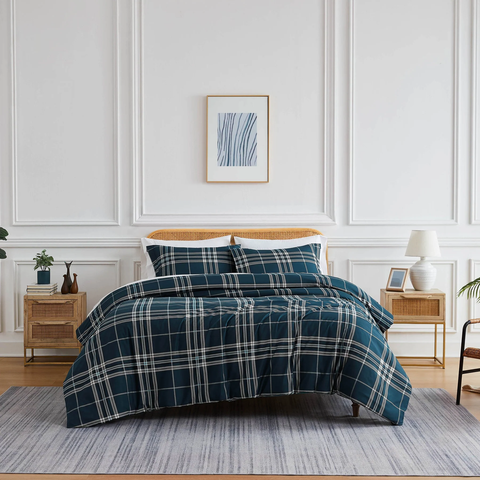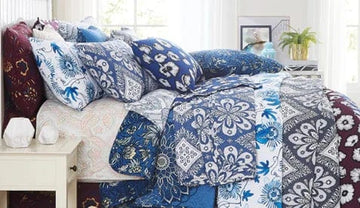Ultimate Comforter Buying Guide: Find Your Perfect Bedding Match
Choosing a comforter for your bed can transform your sleeping experience from acceptable to exceptional.

Whether upgrading your bedding, picking out your first comforter, or seeking a seasonal refresh, the array of options can be overwhelming.
This guide, carefully curated by Southshore Fine Linens, will navigate you through the essentials of comforter selection, ensuring you find the perfect match for your needs, style, and sleep hygiene preferences.
How To Choose a Comforter
When selecting a comforter, consider its fill material, fill power, weight, and how it complements your bedroom decor. Let's dive into these factors to ensure you make an informed decision:
- Fill material: Comforters come in various materials, including down, down alternative, wool, and more. Down comforters, known for their luxurious warmth, are perfect for colder climates. However, if allergies are a concern, alternative comforters offer a hypoallergenic, budget-friendly option.
- Fill power: This measures the loft and quality of the down used. A higher fill power indicates a warmer and more luxurious comforter.
- Weight: Your choice of weight should reflect your personal warmth preference and the climate you live in. Lightweight comforters are ideal for warmer months or climates, while heavier ones are suited for cooler temperatures.
- Thread counts: A higher thread count signifies a softer and more durable comforter, but consider the fabric type to match your desired comfort level
- Comforter size: Ensure you choose a size that fits your bed perfectly. An oversized comforter can offer extra comfort and elegance to your bedding ensemble.
Selecting a comforter that matches your decor is crucial for those looking to enhance their bedroom aesthetics. Consider your room's color, pattern, and overall style when choosing.
How To Choose a Down Comforter
Not sure what to look for when choosing a down comforter? Consider the following unique considerations:
Down Type: Goose vs. Duck
When selecting a down comforter, the type of down used is a significant consideration. Goose down is often preferred for its superior loft and warmth-to-weight ratio compared to duck down. Goose clusters are larger, making them more effective at trapping heat. However, high-quality duck down can also provide excellent warmth and comfort at a more affordable price point.
Shell Fabric: Breathability and Softness
A down comforter's outer fabric, or shell, plays a pivotal role in its performance and feel. Look for shells made from high-thread-count cotton for a soft, breathable cover that will allow moisture to escape, keeping you comfortable throughout the night.
Some comforters feature shells with a tight weave or special coatings to prevent down from poking through, enhancing durability.
Construction Design: Keeping Down in Place
How a down comforter is constructed affects how well it maintains its shape and distributes warmth.
Baffle-box construction involves sewing fabric walls between the top and bottom of the comforter, creating compartments that keep the down evenly distributed. This prevents cold spots and ensures a consistent level of warmth across the entire comforter.
Another design, the sewn-through construction, stitches the top and bottom layers together, creating a lighter comforter suitable for warmer climates or seasons.
Discover the perfect comforter at Southshore Fine Linens.
Down or Synthetic Comforter: Which Is Right for You?
While down comforters are made of natural materials and provide superior warmth, synthetic ones offer a more affordable option suitable for those with allergies. Choosing between down and synthetic comforters boils down to the following:
- Budget: Down comforters, sourced from duck or goose feathers, start around $170 for basic models and can exceed $500 for high-quality options. Synthetic alternatives, like microfiber, are more wallet-friendly, with prices under $50.
- Allergies: Down might not suit allergy sufferers, potentially harboring dust and mites, even with options over $300 labeled hypoallergenic. Synthetics are an affordable, allergy-friendly alternative. It's significantly cheaper and less likely to trigger allergies.
- Seasonal use and care: Down provides superior warmth but may require seasonal swapping and special care, including professional cleaning. Synthetics win for ease of care because they are machine washable and are suitable for all seasons, with the addition of blankets for extra warmth.
- Decor flexibility: Synthetic comforters excel in affordability and variety, ideal for those who frequently update their bedroom look without breaking the bank
In essence, down comforters offer luxury and warmth for those willing to invest more. In contrast, synthetic comforters are budget-friendly, easy to care for, and versatile, making them suitable for a wider range of preferences.
Caring for Your Comforter: Tips and Tricks
Ensuring your comforter remains as inviting as the day you bought it requires simple but effective care techniques.
How To Wash a Comforter
Firstly, always check the label for care instructions specific to your comforter, which can prevent accidental damage. Many comforters are safe for machine washing, but some require special care, like dry cleaning.
Here’s a guide on when your comforter is suitable for home wash:
- Use cold or warm water on a gentle cycle to avoid shrinking or fading
- Use a mild detergent and never use bleach, as it can weaken the fabric fibers
- Rinse twice with cold water to ensure all detergent is removed
Remember that extra-large comforters may require a commercial laundry mat's washing machines as they won't fit in the average household machine.
Drying Your Comforter
When it comes to drying, opt for a low heat setting to avoid damaging the fill; high heat can cause clumping or even burn the fabric. Remove the comforter periodically during drying to fluff it, ensuring even distribution of fill and preventing clumping.
An alternative to using the dryer is air drying. Lay the comforter flat on a clean sheet outside until dry if you have the room. This helps to avoid distortion or damage, especially with heavier comforters.
Regular Maintenance
Regular maintenance is also key. Periodically airing out your comforter on a sunny day can refresh and eliminate odors. Protecting your comforter from daily wear and tear with a duvet cover makes laundering easier and less frequent.
Storage
Proper storage not only saves space but also protects your comforter from dust and pests. Use a breathable bag or container to avoid trapping moisture, which can lead to the growth of mildew.
When folding your comforter for storage, avoid sharp creases to prevent fabric damage and preserve its overall shape. You can roll it to avoid creases as long as it still fits in your storage container of choice.
Consider adding scented sachets, cedar blocks, or mothballs for added protection against pests.
Once your comforter is properly stored in its container, place it in a cool, dry place out of direct sunlight.
The Environmental Impact of Your Comforter Choice
Making an eco-conscious decision when selecting your next comforter can significantly affect your environmental footprint.
While natural and biodegradable, down comforters often raise concerns regarding animal welfare and the sustainability of feather-sourcing practices.
Conversely, synthetic fillers, such as those made from recycled materials, offer an alternative with a potentially lower environmental impact. They reduce landfill waste by repurposing plastic into cozy, hypoallergenic fillings.
When shopping for your next comforter, consider options certified by environmental and ethical standards, like the Global Organic Textile Standard (GOTS) for organic materials, or certifications such as the Responsible Down Standard (RDS).
The Influence of Comforter Choice on Sleep Quality
The right comforter can transform your sleep experience. Temperature regulation plays a crucial role in achieving deep, restorative sleep. Down comforters are renowned for their warmth and breathability, adapting to your body's temperature throughout the night.
However, for those residing in warmer climates or prone to overheating, a lightweight synthetic comforter might provide a more comfortable sleep by wicking away moisture and keeping you cool.
Additionally, the weight and texture of your comforter can affect sleep comfort and quality. Some individuals prefer the snug feeling of a heavier comforter, akin to a weighted blanket's calming effect, while others prefer airier bedding to avoid feeling restricted.
Your comforter's fill, fabric, and weight should align with your personal comfort preferences and sleeping habits to ensure the best night's sleep.
Our beautiful pillow covers complement our comforters. Shop today!
Find the Perfect Comforter at Southshore Fine Linens

Choosing a comforter is easier than ever when you have all the factors and options in mind. Whether you're looking for a lightweight alternative or a luxurious down comforter, Southshore Fine Linens has got you covered with high-quality bedding.
Shop our collection today and transform your bedroom into a cozy haven of relaxation.



